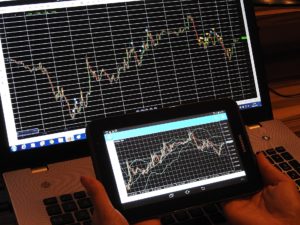In forex trading, correlation is the notable tendency for certain currency pairs to move in agreement.
In that sense, when there is a positive correlation, it is expected that these pairs will keep on drifting in the same direction.
A negative correlation, however, means that the pairs move in opposite directions. With negative correlation, a gain in one currency pair will have another currency pair losing.
One of the most widely accepted reasons for correlation is that the pairs have a base that usually mirrors economic events that affect both currency pairs.
The USDCHF and the EURUSD are two pairs that greatly display how correlation trading works. They both have the US Dollar in the base pair and the cross pair. In a usual trading week, the news affecting the US dollar will affect the USD in both pair.
For example, very poor U.S. GDP results are expected to weaken the dollar. The pairs will however react slightly different because the CHF and the EUR are not always affected exactly the same way.
The EUR and the CHF are mostly correlated because most of the economic conditions that would affect the CHF within the Swiss economy are also likely to be the prevailing conditions around the rest of the European Union countries.
That relationship between the Swiss economy and the European Union economy as a whole makes the CHF and the EUR move in a similar but not exact manner. And, this makes it crucial to understand the statistical aspect of correlation.
A correlation coefficient helps traders gauge how dependent the pairs are. A correlation coefficient of 1.0 shows that the pairs will react exactly in the same manner to market changes by moving to the same direction while a -1.0 coefficient means that the pairs would react exactly in the opposite direction.
Complete 1.0 or -1.0 are rare to come by but figures like 0.26 or 0.80 are more common correlations.
Click here to access a forex correlation tool you can use.
The following are some three trading strategies that a day trader may apply in order to take advantage of the currency correlations.
1. Trading back to the mean
Seasoned traders know when there is a spike that is not well-backed by some economic fundamentals. Unbacked market gossip could, for example, make the EURUSD spike to the bear side and eventually drift back to a previous price.
In such a case, traders could look at the USDCHF and use the difference to tell if the sudden market movement is something that they should completely take into account.
In cases where the EURUSD spikes and the USDCHF has not badged a bit, traders can use that as more reason to treat the spike as an anomaly.
Fading techniques (selling off a spike and counting on the difference in pips to the original price) are applicable.
2. Using correlation to split the risk in a trade
In traditional lot size splitting, traders usually split the lot size into two and place two orders of a single currency pair in order to split the risk into two.
It gives the trader the option to close off one of the trades (half in this case) and keep the other running longer, if the trade does not go exactly as expected.
With correlation trading, risk management can be used to split the risk between two pairs. For example, if a trader is bullish on the dollar, he or she can place half the position in another USD pair that has a high positive correlation.
A 1.0 lot size can be split into a 0.5 lot size on a AUDUSD short position and the other 0.5 on a EURUSD short position.
The lack of a perfect correlation could reduce the risks that come from spikes in any of the two pairs
3. Checking the correlation could prevent traders from trades that cancel out profits
Studying the correlation between pairs will also protect the trader from entering positions that will end up in profits cancelling out. The EURUSD and the USDCHF typically have a correlation of about -0.90.
Theoretically, traders can expect the pairs to keep on moving in opposite directions most of the time.
It beats trading sense to place a long on the EURUSD and a short position on the USDCHF, if the pairs will be expected to move in opposite directions, because the profits made on the EURUSD will be eroded by the losses made on the USDCHF. Got it?
Examining the correlation of a portfolio of open positions can help traders carry out smart risk management to avoid back-tracking on the gained profit positions.
Conclusion
Currency correlation trading is a powerful profit making and risk management tool, but the trader needs to note that correlations between pairs keep on changing with time.
The changes in economic conditions and government policies are great determinants of the correlation existing between pairs.

